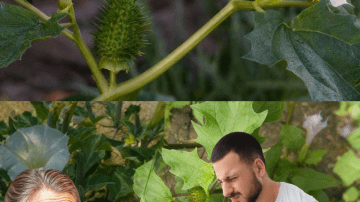Picture this: you’re strolling through a garden at dusk, and a cluster of radiant, trumpet-shaped flowers catches your eye. Their delicate white, purple, or yellow petals glow under the fading light, releasing a sweet, intoxicating fragrance. You lean closer, captivated by their beauty, unaware that you’re standing face-to-face with one of nature’s most dangerous creations—Datura. Known as Devil’s Trumpet or Thorn Apple, this plant is as mesmerizing as it is menacing, hiding a toxic secret that can lead to hallucinations, delirium, or even death. Curious to uncover the truth behind this deceptive beauty? Let’s dive into the world of Datura and explore why this plant is both a marvel and a menace.

🌿 What Is Datura? A Plant with a Dark Side
Datura, a member of the nightshade family (Solanaceae), is a fast-growing plant that thrives in disturbed soils, roadsides, and gardens worldwide. Its striking features—large, trumpet-shaped flowers and spiky, walnut-sized seed pods—make it a favorite among gardeners seeking dramatic flair. But beneath its alluring exterior lies a chilling truth: every part of the Datura plant, from its leaves to its seeds, is laced with potent toxins. Historically used in rituals and traditional medicine, Datura’s unpredictable toxicity makes it a risky encounter, whether by accident or curiosity.
Why does Datura fascinate and terrify? Its dual nature as both a beautiful ornamental and a deadly poison taps into our curiosity about nature’s paradoxes. Let’s explore its characteristics, dangers, and how to stay safe around this captivating yet hazardous plant.
⚠️ The Toxic Secrets of Datura
Datura’s danger lies in its high concentration of tropane alkaloids—chemicals like atropine, scopolamine, and hyoscyamine that disrupt the nervous system. Even a small amount can trigger severe symptoms, making Datura one of the most toxic plants in the natural world. Here’s a closer look at why this plant is so perilous:
💀 Lethal Alkaloids That Target the Body and Mind
Datura’s tropane alkaloids block acetylcholine, a neurotransmitter critical for brain and muscle function. This interference can cause a cascade of alarming symptoms, from confusion to life-threatening complications. Just a single leaf or a few seeds can be enough to send someone into a medical emergency.
🚨 Symptoms of Datura Poisoning
Ingesting or mishandling Datura can lead to a range of terrifying effects, including:
- Hallucinations and Delirium: Vivid, often frightening visions that can last for hours or days.
- Dilated Pupils and Blurred Vision: Sensitivity to light and difficulty seeing clearly.
- Dry Mouth and Difficulty Swallowing: A hallmark of alkaloid poisoning.
- Rapid Heart Rate and High Blood Pressure: Potentially leading to cardiac issues.
- Seizures and Coma: In severe cases, unconsciousness or even death.
Children, pets, and curious foragers are particularly vulnerable, as even a small taste of Datura can be catastrophic.
🌍 A Global Threat in Gardens and Wilds
Datura thrives in diverse environments, from the Americas to Asia and Europe. Its adaptability and striking appearance make it a common sight in neglected gardens, roadsides, or abandoned lots. Unfortunately, its beauty often lures unsuspecting admirers, increasing the risk of accidental exposure.
🌺 Common Datura Species You Might Encounter
Datura comes in several varieties, each as stunning as it is dangerous. Here are the most common species to watch out for:
🌟 Datura Stramonium (Jimsonweed or Thorn Apple)
Known for its white or purple trumpet-shaped flowers and spiky seed pods, Datura stramonium is infamous for its hallucinogenic effects. However, its high alkaloid content makes even small amounts potentially fatal.
🌼 Datura Metel (Horn of Plenty)
This species boasts showy, double-layered flowers in white, yellow, or purple. Often grown for ornamental purposes, it remains highly toxic and should be handled with care.
🌙 Datura Inoxia (Moonflower)
With its fragrant, night-blooming white flowers, Datura inoxia is often mistaken for harmless moonflower vines. This confusion has led to accidental poisonings, as its seeds and leaves are equally dangerous.
🌵 Datura Ferox (Long-Spined Thorn Apple)
Distinguished by its extra-large, spiky seed pods, Datura ferox has some of the highest alkaloid levels, making it one of the most lethal species in the genus.
🩺 Historical Uses: Medicine or Menace?
Datura’s history is as complex as its chemistry. For centuries, cultures worldwide have used it in traditional medicine and spiritual rituals. From treating asthma and pain to inducing visions in shamanic ceremonies, Datura was revered for its potent effects. However, the line between a therapeutic dose and a toxic one is razor-thin, and modern health experts strongly discourage its use due to its unpredictability.
Why does Datura’s past matter? It reminds us that even plants with medicinal potential can pose serious risks when mishandled. Today, safer alternatives exist for treating conditions once addressed with Datura, making its use largely obsolete outside controlled settings.

🚫 Why You Should Avoid Datura in Your Garden
Despite its beauty, Datura is a risky choice for landscaping. Its toxicity poses a threat to children, pets, and even adults who may not recognize its dangers. Here’s why you should think twice before planting or keeping Datura:
🐶 Danger to Pets and Children
Curious pets or children may be drawn to Datura’s spiky pods or fragrant flowers, putting them at risk of accidental ingestion. A single seed pod can contain enough toxins to cause severe poisoning.
🌱 Unpredictable Spread
Datura spreads easily through seeds carried by birds or wind, often popping up unexpectedly in gardens or yards. Its resilience makes it difficult to eradicate once established.
⚡ Risk of Accidental Exposure
Even handling Datura without gloves can cause skin irritation or accidental absorption of toxins through cuts or mucous membranes. Gardeners must exercise extreme caution.
🛡️ How to Stay Safe Around Datura
Encountering Datura in the wild or your garden doesn’t have to be a disaster if you take the right precautions. Here’s how to protect yourself and your loved ones:
🔍 Identify and Avoid
Learn to recognize Datura by its trumpet-shaped flowers, spiky seed pods, and jagged leaves. If you spot it in your yard, avoid touching it with bare hands.
🧤 Remove It Safely
If you need to remove Datura, wear gloves, long sleeves, and protective eyewear. Pull up the entire plant, including the roots, and dispose of it in a sealed bag to prevent regrowth or accidental exposure.
🚨 Seek Immediate Help
If you suspect Datura poisoning, seek emergency medical attention immediately. Symptoms can escalate quickly, and prompt treatment is critical.
📚 Educate Your Family
Teach children and pet owners in your household about the dangers of Datura. Awareness is the first step in preventing accidental poisoning.
🌟 The Bigger Picture: Nature’s Paradox
Datura is a perfect example of nature’s complex balance—beauty intertwined with danger. Its alluring flowers and dark history captivate our imagination, but its toxicity demands respect. By understanding Datura’s risks and taking precautions, you can admire its beauty from a safe distance without falling victim to its deadly secret.
💡 Final Thoughts: Stay Curious, Stay Cautious
Datura’s enchanting appearance may tempt you to take a closer look, but its hidden dangers make it a plant best left untouched. Whether you’re a gardener, a nature enthusiast, or simply curious about the world around you, knowing how to identify and avoid Datura is essential for your safety. Have you encountered this deceptive plant in your garden or travels? Share your story and spread awareness about its risks. Let’s keep the beauty of nature alive—without falling prey to its darker side.






